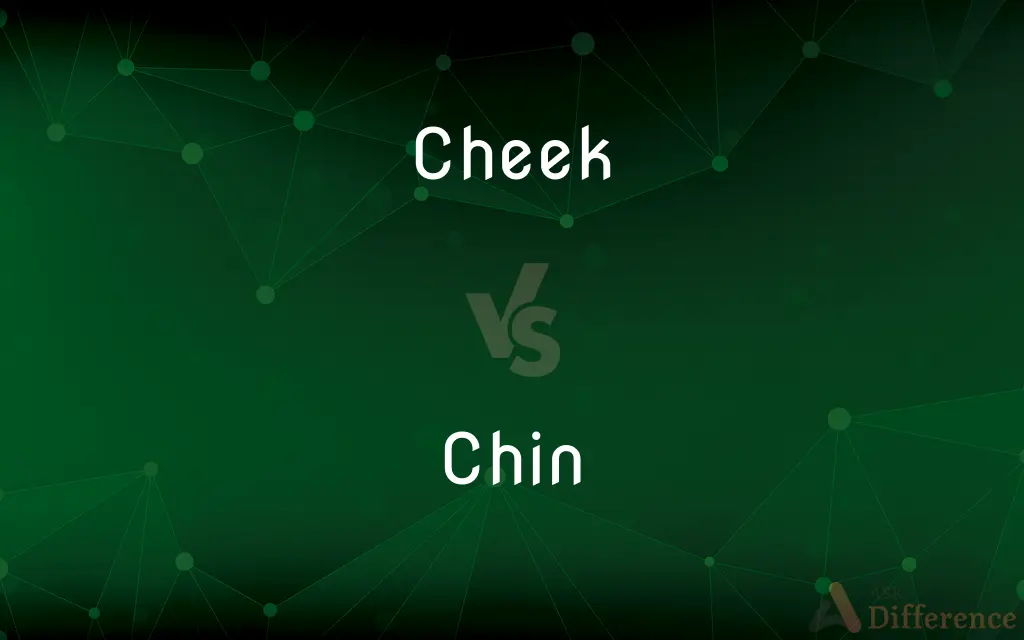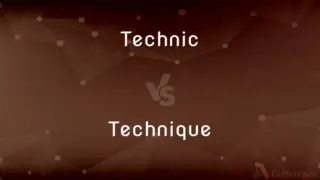Cheek vs. Chin — What's the Difference?
Edited by Tayyaba Rehman — By Urooj Arif — Updated on March 15, 2024
Cheeks are the fleshy areas forming the sides of the face below the eyes, contributing to facial expressions, while the chin is the protruding part of the face below the mouth, often associated with determination or character.

Difference Between Cheek and Chin
Table of Contents
ADVERTISEMENT
Key Differences
Cheeks play a significant role in the facial structure, comprising the area between the nose, eyes, and jawline. They are pivotal in facial expressions, as they move when we smile, frown, or speak, and they contribute to the overall shape and appearance of the face. The chin, on the other hand, is the forward-pointing part of the lower jaw and is unique in its prominence in humans among primates. The shape and size of the chin can vary greatly among individuals and is often considered a marker of attractiveness and personality traits.
Cheeks are also crucial for holding food in place during chewing and are the site for the application of makeup, such as blush, to highlight facial features. Unlike the cheeks, the chin does not play as active a role in facial expressions, but it contributes to the overall profile and symmetry of the face.
In terms of anatomy, the cheeks are composed of various muscles, fat, and connective tissues that allow for a wide range of movements, whereas the chin primarily consists of the mandible bone and overlying skin. The health and appearance of both cheeks and chin can be affected by factors such as diet, genetics, and aging, with cosmetic procedures available to alter their appearance if desired.
Understanding the differences and functions of the cheeks and chin is essential in fields such as medicine, dentistry, and aesthetics, where precise knowledge of facial anatomy is crucial for diagnoses, treatments, and cosmetic enhancements.
Comparison Chart
Location
Sides of the face below the eyes, above the jawline.
Protruding part of the face below the mouth.
ADVERTISEMENT
Function
Aid in facial expressions, hold food during chewing.
Contributes to facial symmetry, associated with character.
Composition
Muscles, fat, connective tissue.
Primarily the mandible bone and skin.
Cultural Significance
Often highlighted with makeup, associated with youth and health.
Associated with traits like determination and attractiveness.
Variability
Size and fullness can vary, affecting facial shape.
Shape and size vary, influencing facial profile.
Compare with Definitions
Cheek
The fleshy parts of the face between the eyes, nose, and jaw.
Her cheeks flushed with embarrassment.
Chin
The forward part of the lower jaw.
He stroked his chin thoughtfully during the conversation.
Cheek
Involved in facial expressions and speech.
He puffed out his cheeks while playing the trumpet.
Chin
Plays a role in facial symmetry but not in expressions.
A well-defined chin contributes to a balanced facial profile.
Cheek
Can be enhanced with makeup for aesthetic purposes.
She applied blush to her cheeks for a rosy glow.
Chin
Subject to cosmetic alterations for enhanced appearance.
Chin implants can alter the contour of the face.
Cheek
Essential for holding food in place during mastication.
Cheeks help keep the food between the teeth for efficient chewing.
Chin
Associated with personality traits in cultural contexts.
Leaders are often depicted with strong chins in portraits.
Cheek
Their fullness can signify youthfulness and health.
The baby's round cheeks were a sign of good health.
Chin
Variations in shape and size impact overall attractiveness.
A prominent chin is considered attractive in many cultures.
Cheek
The cheeks (Latin: buccae) constitute the area of the face below the eyes and between the nose and the left or right ear. "Buccal" means relating to the cheek.
Chin
The human chin (also known as the mental protuberance, mental eminence and, rarely, mental osseum, tuber symphyseos) refers to the forward pointed part of the anterior mandible (mental region) below the lower lip. A fully developed human skull has a chin of between 0.7 cm and 1.1 cm.
Cheek
The fleshy part of either side of the face below the eye and between the nose and ear.
Chin
The central forward portion of the lower jaw.
Cheek
Something resembling the cheek in shape or position.
Chin
To pull (oneself) up with the arms while grasping an overhead horizontal bar until the chin is level with or above the bar.
Cheek
Either of the buttocks.
Chin
(Music) To place (a violin) under the chin in preparation to play it.
Cheek
Impertinent boldness
Had the cheek to insult his hosts.
Chin
To chin oneself.
Cheek
To speak impudently to.
Chin
(Informal) To make idle conversation; chatter.
Cheek
(anatomy) The soft skin on each side of the face, below the eyes; the outer surface of the sides of the oral cavity.
Chin
The bottom of a face, the typically jutting jawline below the mouth.
Cheek
The lower part of the buttocks that is often exposed beneath very brief underwear, swimwear, or extremely short shorts.
Chin
Talk.
Cheek
Impudence.
You’ve got some cheek, asking me for money!
Chin
A lie, a falsehood.
Cheek
One of the genae, flat areas on the sides of a trilobite's cephalon.
Chin
A person of the upper class.
Cheek
One of the pieces of a machine, or of timber or stonework, that form corresponding sides or a similar pair.
The cheeks of a vice
The cheeks of a gun carriage'
Chin
The ability to withstand being punched in the chin without being knocked out.
Cheek
(nautical) pump-cheek, pump-cheeks, a piece of wood cut out fork-shaped in which the brake is fastened by means of a bolt and can thus move around and move the upper box of the pump up and down
Chin
(aviation) The lower part of the front of an aircraft, below the nose.
Cheek
(in plural) The branches of a bridle bit. .
Chin
The bottom part of a mobile phone, below the screen.
Cheek
Either side of an axehead.
Chin
(informal) A chinchilla.
Cheek
(metalworking) The middle section of a flask, made so that it can be moved laterally, to permit the removal of the pattern from the mould.
Chin
To talk.
Cheek
To be impudent towards.
Don't cheek me, you little rascal!
Chin
To talk to or with (someone).
Cheek
To pull a horse's head back toward the saddle using the cheek strap of the bridle.
The squirrel cheeked some nuts before heading back to it's nest.
Chin
To perform a chin-up exercise in which one lifts one's own weight while hanging from a bar.
Cheek
The side of the face below the eye.
Chin
To punch or hit (someone)'s chin part of the body.
Cheek
The cheek bone.
Chin
(transitive) To put or hold (a musical instrument) up to one's chin.
Cheek
Those pieces of a machine, or of any timber, or stone work, which form corresponding sides, or which are similar and in pair; as, the cheeks (jaws) of a vise; the cheeks of a gun carriage, etc.
Chin
(transitive) To turn on or operate (a device) using one's chin; to select (a particular setting) using one's chin.
Cheek
The branches of a bridle bit.
Chin
(transitive) To put one's chin on (something).
Cheek
A section of a flask, so made that it can be moved laterally, to permit the removal of the pattern from the mold; the middle part of a flask.
Chin
(transitive) To indicate or point toward (someone or something) with one's chin.
Cheek
Cool confidence; assurance; impudence.
Chin
The lower extremity of the face below the mouth; the point of the under jaw.
Cheek
To be impudent or saucy to.
Chin
The exterior or under surface embraced between the branches of the lower jaw bone, in birds.
Cheek
Either side of the face below the eyes
Chin
The protruding part of the lower jaw
Cheek
An impudent statement
Chin
Kamarupan languages spoken in western Burma and Bangladesh and easternmost India
Cheek
Either of the two large fleshy masses of muscular tissue that form the human rump
Chin
In gymnastics: raise oneself while hanging from one's hands until one's chin is level with the support bar
Cheek
Impudent aggressiveness;
I couldn't believe her boldness
He had the effrontery to question my honesty
Cheek
Speak impudently to
Common Curiosities
Can losing weight change the appearance of the cheeks and chin?
Yes, weight loss can reduce the fat in the cheeks and chin, leading to a more defined facial structure, but the extent varies among individuals.
Is there a correlation between chin size and gender?
Generally, men tend to have more pronounced chins due to hormonal differences, but there is considerable overlap, and individual variations are significant.
Are high cheekbones universally considered attractive?
High cheekbones are often associated with attractiveness in many cultures, but beauty standards can vary widely across different societies.
Can the shape of the cheeks or chin be altered naturally?
While genetics largely determine their shape, diet, exercise, and certain facial exercises might have minimal effects. Cosmetic procedures are more effective for significant alterations.
Does the chin have any functional purpose besides aesthetics?
The chin supports the lower lip and helps in closing the mouth, but it does not have as dynamic a role as other facial features like the cheeks.
What are dimples, and how are they formed?
Dimples are small indentations on the cheeks, often visible when smiling, caused by variations in the underlying facial muscles.
How do facial expressions impact the cheeks?
Facial expressions, especially smiling and laughing, involve the movement of cheek muscles, which can enhance the cheeks' prominence.
Are there any medical conditions that affect the cheeks or chin?
Conditions like edema, mumps, and temporomandibular joint disorders can affect the cheeks and chin, altering their appearance and function.
Why do some people have a double chin, and can it be reduced?
A double chin can result from excess fat, genetics, or aging. It can be reduced through weight loss, exercises, and cosmetic procedures like liposuction.
Can dental health impact the appearance of cheeks and chin?
Yes, dental health and the alignment of teeth can influence the contour and fullness of the cheeks and the prominence of the chin.
Do all cultures value the same cheek and chin characteristics?
Cultural beauty standards vary, so the desired characteristics of cheeks and chin can differ significantly from one culture to another.
How do cheeks contribute to speech?
Cheeks help in controlling airflow and maintaining the shape of the oral cavity, which is crucial for articulation and sound production.
Is chin augmentation a common cosmetic procedure?
Yes, chin augmentation is quite common and can involve implants or reshaping to enhance the chin's appearance and facial harmony.
How does aging affect the cheeks and chin?
Aging can lead to a loss of fat and elasticity in the cheeks and sagging skin around the chin, altering the face's youthful contours.
Can facial hair influence the perceived size and shape of the chin?
Yes, facial hair, especially a beard or goatee, can significantly alter the perceived shape and prominence of the chin.
Share Your Discovery

Previous Comparison
Technic vs. Technique
Next Comparison
Tart vs. TorteAuthor Spotlight
Written by
Urooj ArifUrooj is a skilled content writer at Ask Difference, known for her exceptional ability to simplify complex topics into engaging and informative content. With a passion for research and a flair for clear, concise writing, she consistently delivers articles that resonate with our diverse audience.
Edited by
Tayyaba RehmanTayyaba Rehman is a distinguished writer, currently serving as a primary contributor to askdifference.com. As a researcher in semantics and etymology, Tayyaba's passion for the complexity of languages and their distinctions has found a perfect home on the platform. Tayyaba delves into the intricacies of language, distinguishing between commonly confused words and phrases, thereby providing clarity for readers worldwide.














































